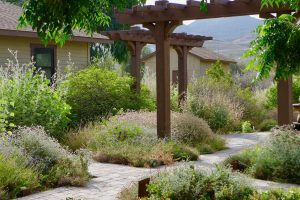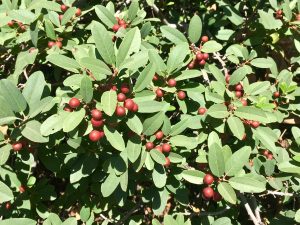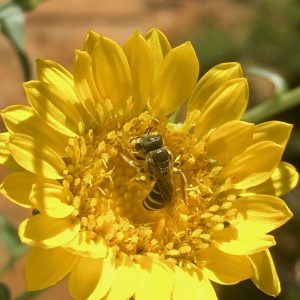July in the Natural Garden
- Posted in: Blog, Monthly Garden Advice
- Tags Seasonal Gardening
July in the natural world of southern California is calling you to come see. You can start an excursion out to hill and dale anytime, even after lunch, and enjoy a leisurely drive to see summer in the raw, with a return around dark, say, 9:00 pm. Long days are great.
In the creeks, sycamore, willow, and cottonwood are in full leaf, as in no more leaves could possibly fit on this tree. Of course, the insect and bird populations coincide with this abundance, so you will notice plenty of movement out there. On the sidehills, buckwheat in bloom with extreme pollination underway, bees, and butterflies everywhere; toyon, chamise, and sugarbush attracting their share of attention. You’ll catch glimpses of gallery forests, oaks and sycamores in the canyons and you’ll see redtails circling high in the thermals above the ridges.
On your return drive, you might head directly into the evening sun. Though you were only gone a few hours, you will feel you have accomplished a great journey, because that lizard on that rock, and those grasses in that breeze, and them there exact clouds in that very sunset sky, brought to mind every lizard, every meadow, and every panorama you have ever seen. You can take summer with you into your dreams.
This year, 2019, we are experiencing a “textbook” season for early summer. Hot inland (90’s-100+), grey at the coast (70’s) with the clouds burning off midday a few miles from the beach (70’s -80’s), marine layer returning at dusk, cooler at night (mid 60’s). This is perfect weather for plants to acclimate in preparation for the real thing coming… hot summer… long days of July and August, with possibilities of extreme heat events arriving anytime, including well into September. Here’s what we can do to help our gardens get ready:
 Watering
Watering
It bears repeating. Watering native plants and natural gardens in summer is so easy that, once you are comfortable and expert in the practice, you will be astounded that it remains such a mystery for so many people. If it is still a mystery to you, no problem… here’s the formula:
during a summer cool spell, irrigate to the equivalent of 1-1.5” of rainfall by running your sprinklers for about 30 minutes, every day for 3 days in a row, early in the morning. This cumulative 90 minutes of irrigation will translate to a little over 1” of water. Wait 3-4 weeks. Repeat the process. This is your Deep Soak irrigation event and you only need about 4-6 per year.
Refreshing Sprinkle – anytime on any summer afternoon, as often as twice a week or so, go out in late afternoon before sunset and cool down your whole garden for 5 minutes with a spray nozzle on the hose… or use your sprinklers. Five minutes. Just wet the foliage and the top of the soil. You will not be watering the root zone. The plants will immediately cool down and you will have spent a few minutes checking out your garden. Who knows, a hummingbird may fly in for a quick shower.
For all the information you need on the subject see Watering Native Plants.
Related to Watering
Presumably, the plants in your natural garden include trees, shrubs, sub-shrubs, ground covers, accents, maybe even a few volunteer seedlings, all manner of plants, perhaps some new and some old. Now try to picture the rhizosphere, the root zone, the plant-life underground. You have roots of all shapes and sizes, thick, thin, fibrous, fleshy, and at all depths from 4-16”, each root system requiring consistent moisture and lots of oxygen in the soil’s pore spaces.
This is not a competition for water and resources, but rather a mass co-op of entangled roots from so many species, happy that you are applying water about once a month, enough to penetrate deep, so they will find water and oxygen when and where they need it; the soil, at root depth. Use a soil probe or dig a 4-8” deep inspection hole to assess soil moisture.
Pruning
No major pruning or thinning in July. If you have not cut the old flowers/seed heads off your ceanothus that bloomed in April/May, do it before it gets hot. Some salvia varieties are finishing their flowering and can be cleaned up by removing the flowering stems clear back to the main plant. You will be shaping the plant and removing the seed stalks at the same time. If you prune old penstemon flowers, check to see if the seed capsules contain ripe seed (capsules brown, seeds black). You can save the seed for sowing elsewhere or give some to your friends this fall.
If you see tender new growth (quite possible still in shade) you can pinch off the very tips of the branches to encourage side shoots to make a denser, more compact plant.
Weeding
With properly timed summer irrigation and diligent attention to weeds last spring, you should have a clean garden now. Obviously, if warm-season weeds are sprouting, you can hoe or pull them. Remove and discard the cut plants to be sure you are not leaving weed seeds behind. Perennial warm-season grasses like bermuda can be controlled with herbicides. Follow label instructions and be careful to produce zero drift and no overspray that would affect your plants.
Mulching/Topdress
No new mulch during the warm season. No need to cultivate the mulch you have in place unless for some reason it is too thick and won’t let the irrigation water penetrate. In that case, scratch it up with a 3-prong cultivator. Let some air in. This is one reason we never pile mulch too thick.
Feeding
No feeding during the summer months, unless remedial (see June 2019) to solve problems with nutrient deficiency, or on potted plants.
Troubleshooting – Varmints, Pests, and Diseases
Varmints – Bunnies and ground squirrels are bolder because they are older and wiser than they were in the spring. Pray that the hawks and owls have success.
Pests – Insect pests on natives are usually few in summer because new growth on plants is hardening and branches are less attractive. You need to continually watch for Argentine ants that can undermine your plants’ root systems and move injurious insect pests around for their benefit. Ants will tend whole herds of scale, mealybug, and aphid, feeding on the sweet excretion called honeydew. Ant control is tricky. Growth regulators work better than poisons.
 Annual Wildflowers
Annual Wildflowers
July is definitely not the time to sow seed, but you can have a lot of fun collecting seed from all your plants, especially sub-shrubs and annual wildflowers. Enjoy gathering, cleaning, sorting, cataloging, and preparing for fall planting. Or just gather all the seed and seed stalks in paper bags, mangle it up, and spread it thin as mulch or top dress in a bare area after the first rain.
Adding New Plants
It’s always fun to bring new plants into the garden. Summer is a good time to add desert plants or other heat-loving species if they fit into your narrative. Also, you can plant and establish natives in the shade quite easily now, as the long days will promote plant growth. Planting near the immediate coast is safe all year.
Planting in full sun can be a little more tricky. Always follow our planting instructions and use water while planting, building a wide watering basin, and a secondary watering ring where appropriate. Check “Plant it Right” on YouTube or download our planting instructions “Planting Guide”. In full sun plantings, you should take precautions for temporary shade, like making a little “tent” of fan palm leaves in the event that we get extremely hot bright sun in the days and weeks after initial planting.
Engage
July in your natural garden is calling you to come see too. With so little horticultural activity needed this month, you will have a lot of time to see everything up close. Just take time to stroll through or sit quietly in your garden. Pollinator activity will be intense and even seem a bit chaotic, but in actuality it’s just your garden’s heartbeat in the heat, pounding hard. Early mornings and late evenings are often best, but even at midday, when the sun, the flowers, and so many bee species are all screaming “It’s hot out here!” you will experience a little raw nature in your very own refined garden. And you will be reminded of California’s wild side, who is also calling you to come see, even if for only a few hours at a time.
From the Garden,
Mike Evans
Questions? Help is just one call or one email away. Call (949) 728-0685 or email (with pictures if you like) our special helpline: gardenhelp@californianativeplants.com
To get our monthly updates sign up for our eNewsletter at this link here.